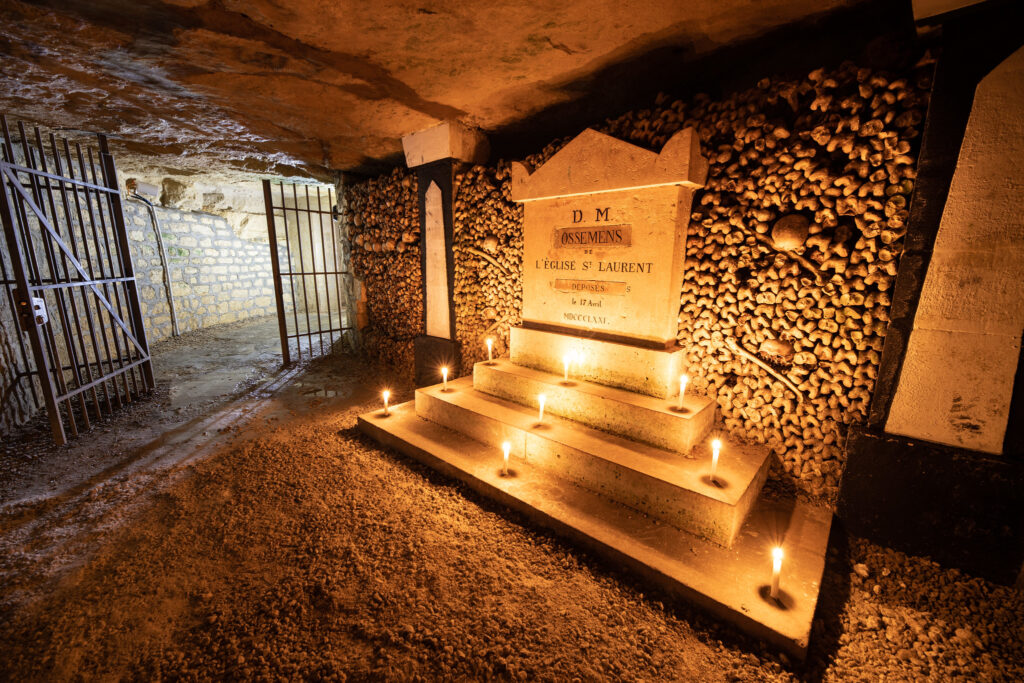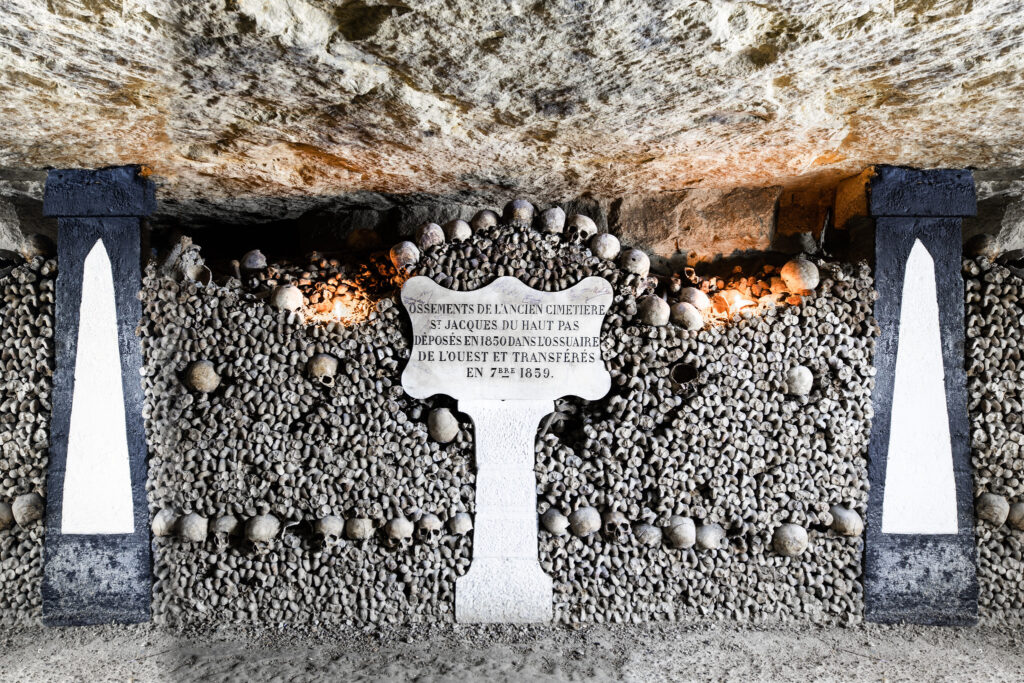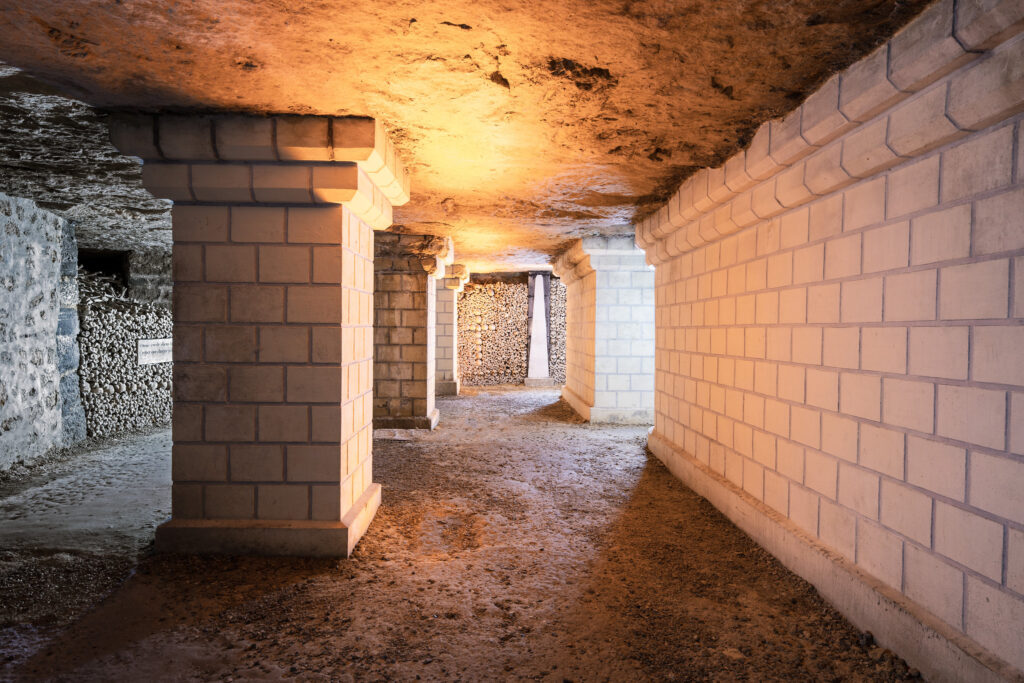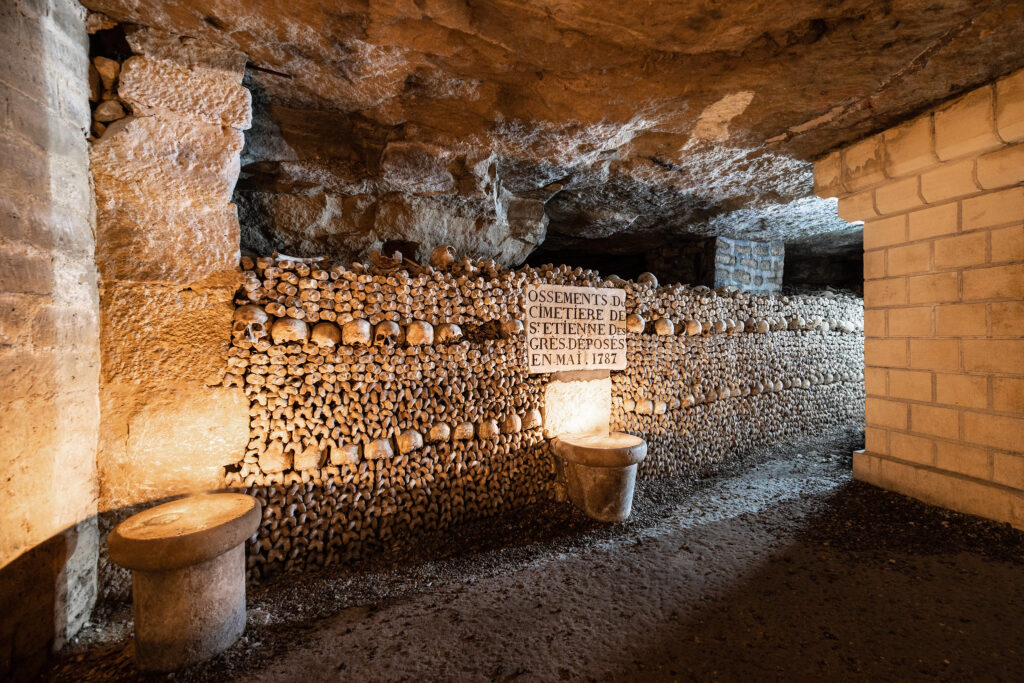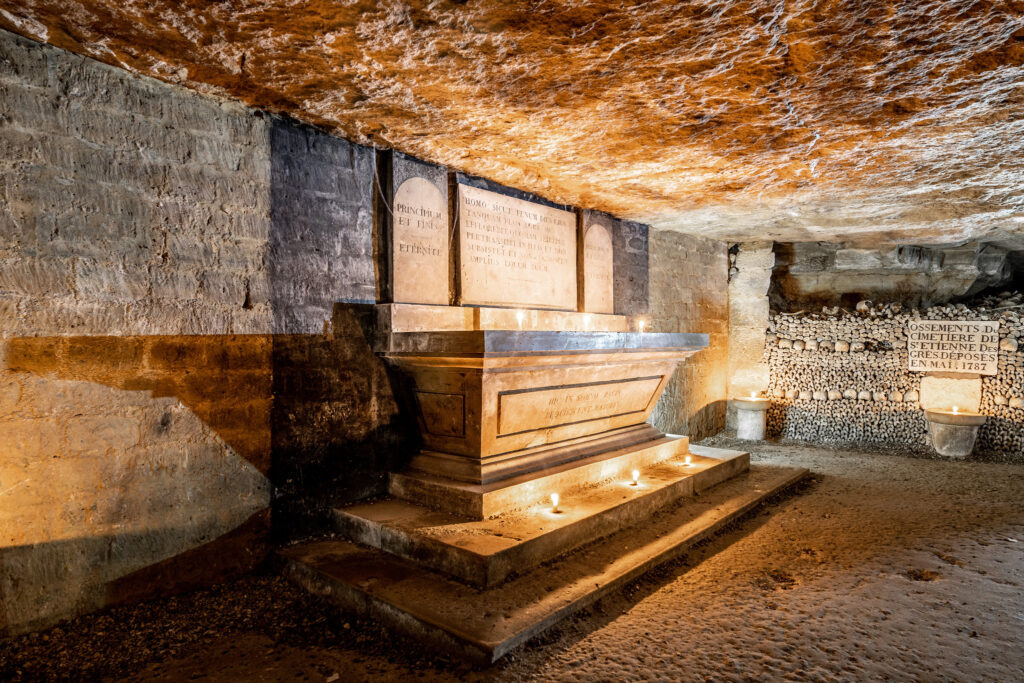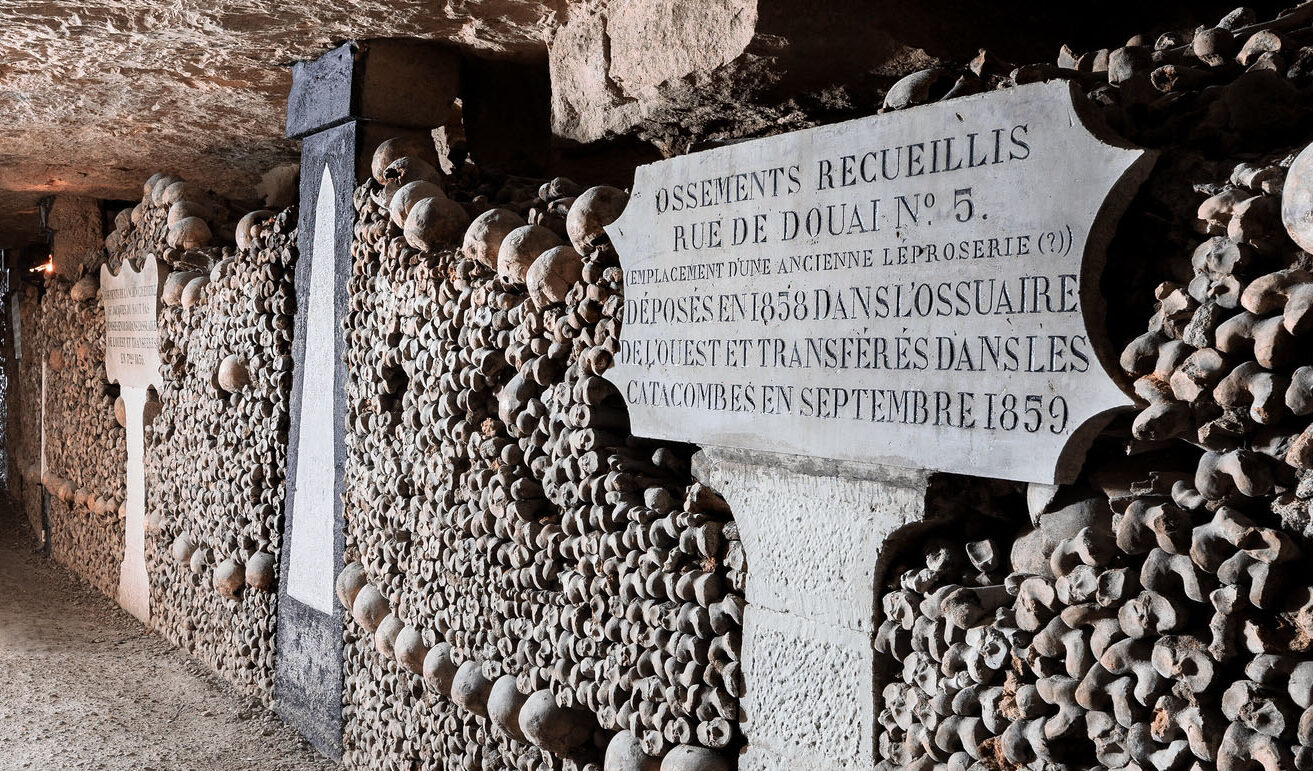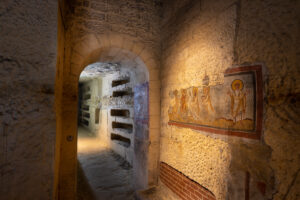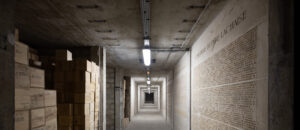Dive into the heart of the mysterious catacombs of Paris
Welcome to our immersive virtual tour of the famous Paris catacombs. Thanks to 360° technology, you will be able to explore this fascinating underground labyrinth as if you were there, while discovering its captivating history.
A journey through time 20 meters underground: Virtual tour
This virtual journey takes you 20 meters below the bustling streets of the French capital, into a network of galleries several centuries old. You will be able to observe up close the limestone walls formed 45 million years ago, when the sea still covered the Paris region. Move from gallery to gallery, and click on points of interest to obtain more information.
Key points :
- The Paris catacombs are an underground network of 150 km of galleries.
- They house the remains of over 6 million Parisians.
- Created in the 18th century to solve sanitary problems in Parisian cemeteries.
- Open to the public since 1809 with a visit route of 1.5 km.
The fascinating history of the Paris Catacombs
The Paris Catacombs are a unique and mysterious place that attracts hundreds of thousands of visitors each year. This underground network of galleries extends for about 150 km beneath the streets of the French capital. But where do these catacombs come from and why were they created?
In the 18th century, Paris faced a big problem: its cemeteries were overflowing and causing sanitary issues. To solve this problem, the idea was to transfer the bones to old underground quarries. That’s how the catacombs were born! Between 1785 and 1787, the remains of millions of Parisians were moved there.
Today, the catacombs house the bones of over 6 million people. It’s hard to imagine so many skeletons gathered in one place! These underground galleries have become a true ossuary, which is a place where bones are kept.
A visit to the bowels of Paris
Since 1809, a small part of the catacombs has been open to the public. The tour route is about 1.5 km long. When you enter, you descend a spiral staircase of 131 steps. It’s like diving into the bowels of the city!
Once at the bottom, you find yourself in a completely different world. The galleries are dark and cool. The walls are covered with carefully stacked bones and skulls. It’s both impressive and a little frightening.
During the visit, you can see sculptures made with bones, inscriptions carved in stone, and even an underground fountain. Every corner of the catacombs has a story to tell.
The macabre art of the catacombs
The Paris Catacombs are not just a simple ossuary; they constitute a true place of macabre art where death is staged in an elaborate manner. The bones are carefully arranged in a monumental funerary decor, adorned with Doric pillars, altars, and engraved plaques. The famous inscription “Stop, this is the empire of death” welcomes visitors, while numerous sentences and maxims add a meditative dimension to the tour, inviting everyone to reflect on life and mortality.
This artistic staging transforms human remains into elements of a vast aesthetic composition. Skulls and tibias are creatively arranged, forming striking patterns. Sculptures and engravings in the stone tell the history of the catacombs and illustrate allegorical themes related to death. This ensemble makes the catacombs a unique place, combining art, architecture, and philosophy.
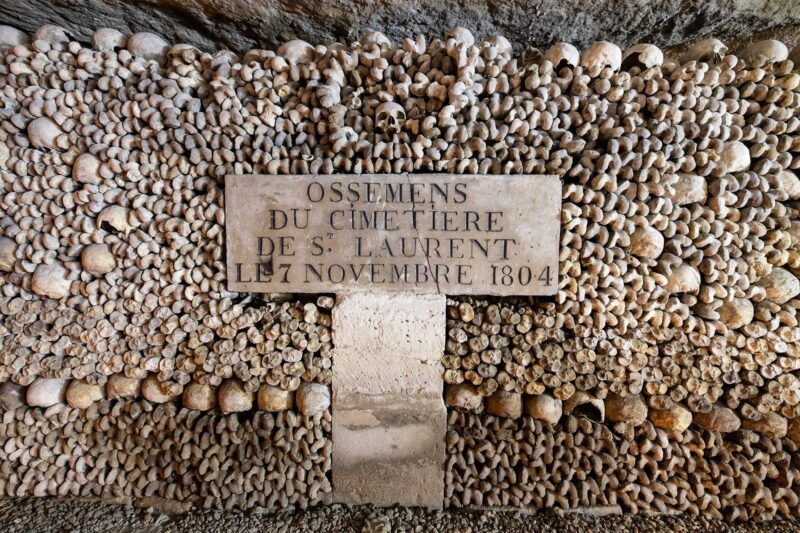
The mysteries and legends of the catacombs
As one might expect, such a unique place as the catacombs has given rise to many legends. Some say they are haunted by the spirits of the dead whose bones rest there. Others tell stories of secret passages leading to hidden treasures.
A popular legend speaks of a man who got lost in the catacombs during the French Revolution and whose body was found 11 years later. Even if this story is probably not true, it shows how much the catacombs both fascinate and frighten at the same time.
These legends add a layer of mystery to an already very special place. They contribute to making the catacombs a place that both attracts and unsettles.
Illegal exploration of the catacombs
Only a small part of the catacombs is open to the public. But that doesn’t stop some people from wanting to explore the rest of the network. These explorers, called “cataphiles,” illegally venture into the closed parts of the catacombs.
This activity is very dangerous. It’s easy to get lost in this underground labyrinth. Moreover, some galleries can collapse. Despite these risks, cataphiles continue their explorations, attracted by the adventure and secrets of the catacombs.
The police regularly patrol to prevent these intrusions. But the network is so vast that it’s impossible to monitor everything.
The catacombs in popular culture
The Paris catacombs have inspired many artists. They appear in books, movies, and even video games. For example, Victor Hugo’s novel “Les Misérables” mentions the catacombs. More recently, the horror film “As Above, So Below” takes place entirely in the catacombs.
These representations in popular culture help maintain the mystery and fascination surrounding the catacombs. They often present them as a frightening and dangerous place, which is not always true to reality, but fuels public curiosity.
This presence in popular culture also has an impact on tourism. Many visitors come to the catacombs after seeing a film or reading a book that mentions them.
Preserving Paris’s Underground Legacy: Challenges and Controversies
Maintaining the Paris Catacombs poses ongoing challenges for conservationists. Water infiltration and high humidity levels threaten the integrity of galleries, bones, and decorations. Additionally, the site’s popularity among tourists impacts its preservation efforts.
Dedicated teams meticulously work to strengthen galleries, clean osseous remains, and maintain the site’s structural integrity. This painstaking process involves handling centuries-old human remains with utmost care and respect.
Catacombs conservation serves dual purposes: preserving a unique historical site and ensuring visitor safety. The General Inspection of Quarries (IGC) plays a crucial role in this effort. Established in 1777, the IGC oversees subsoil stability in Paris and surrounding areas. It intervenes in urban planning processes, mandates subsoil studies, and prescribes necessary consolidation work.
The conservation of the catacombs is important not only to preserve this historic site, but also to ensure the safety of visitors and Parisians living above.
Ethical Considerations
The Catacombs’ existence raises profound ethical questions. Originally created in 1785 to address public health concerns from overcrowded cemeteries, the site only opened to visitors in 1809.. This transformation prompts debate: Is it ethically justifiable to display millions of human remains without their consent as a tourist attraction?
Conservation efforts must balance preservation, safety, and ethical concerns. As Paris continues to evolve above ground, the challenge of maintaining its underground heritage remains a complex and ongoing task.
